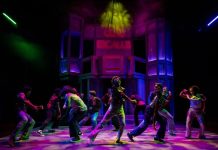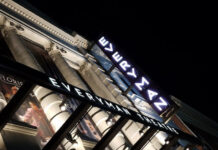Director Rami Khader, along with a group of talented and committed artists, both male and female and of differing ages and backgrounds, founded Diyar Dance Theatre in 2008. Based in Bethlehem, their mission is to bring Palestine’s rich history and culture to life through dance, movement, and theatre.
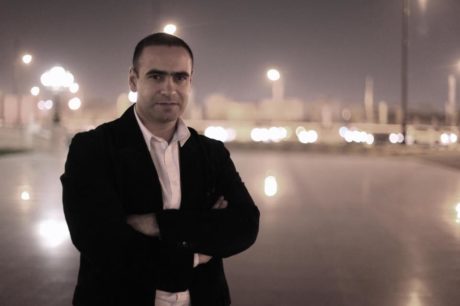
Diyar uses creative performance art training to inspire young Palestinians to proactively advocate for constructive social change. Youth, often unable to contribute their voice to society, are given the freedom to create unique dance and theatre pieces which speak to a variety of topics. One of their latest projects is Women, about the lives of women in Palestine. It came about through the support of Philadelphia-based dancer and choreographer Nicole Bindler, who also organized and fundraised for the 2017 tour through the U.S., starting in Philadelphia, followed by performances and/or workshops in Chicago, New York, and Connecticut.
Director Khader shared some of his experiences about Diyar and the active engagement from dancers and theater artists in the U.S.
Henrik: You live in Palestine, yet you describe the Diyar Theatre as “a space where creativity, imagination, and freedom of expression are celebrated as critical components of cultural and social development.”
Rami: The Israeli occupation is not only about occupying land and space but also people’s minds and hearts, in which the occupied get used to oppression and adapt it as a lifestyle or an attitude toward the less powerful in our society, such as women and children. Occupying minds is more dangerous than the physical land occupation because people cannot be free when their minds are polluted and distressed.
This is why exploring self-image and identity through arts, theatre, and dance help Palestinians to humanize their experience and be able to creatively resist the occupation and the hard economic, social, and political reality surrounding us. It is important to freely express not only political frustrations and struggles but also personal and community struggles, which enables us to establish expressive channels for our children and youth.
Could you describe what vision you have for Diyar and the main hurdles that all of you face?
I want Diyar Theatre to continue to grow and be a force for change in our community, using dance and theatre to enact change on both a political and a social level. Our vision remains not only to survive but thrive as we provide our young people with a space to explore themselves and express who they are through artistic training and development.
What new practices and/or visions have your guest teachers from Germany, the U.K., and the U.S. introduced to your theater?
Our international artists help Diyar to develop emerging approaches to dance and theatre. Collaboration is very important to us because it brings diverse artistic expressions and political viewpoints to people who are eager to see something different.
We value working with our colleagues and friends because of the way we all shape our different identities in creating new forms of art. More importantly, theatre connects us with dancers, actors, and directors to creatively resist the occupation. We can reach out to local and international audiences that are fed up with one-sided news, political talks, and merely reading about the Palestinian struggle.
How did you and your students respond to these international approaches?
We were lucky to have worked with Dr. Joe Martin from Johns Hopkins University as a theatre director. Together, we produced Boesman and Lena, a South African drama by Athol Fugard, tackling issues of racism and social divide in the apartheid era.
We have also worked with Renee Austin, a choreographer based in California, who actually choreographed our show Out of Place. She was supposed to work with us again on our most recent production, but she was denied entry by the Israeli authorities.
We are keen to inject our folk dance with contemporary practices and this is why we have been working with many international dancers and choreographers. I believe art, dance, and theatre are dynamic and need to be shaped and formed across cultures, as this enriches the experience.

Nicole Bindler, a well-known Philadelphia choreographer and director, worked with your dancers on a new program called Women. Tell us about that experience and what you hope to achieve with the performances in Palestine and the U.S.
It has been great to be able to work with Nicole on producing this particular dance performance and present it both at home and abroad. We hope that the discourse this production brings to the art scene in America will change how people feel about Palestinians, as our image has been distorted and scattered by the mainstream media here in the U.S.
What were your initial responses to the feminist perspective of Nicole and other Western teachers?
A big part of our work is about Palestinian women. It is very important to create a discourse about issues surrounding women in Palestine, especially when it comes to hardships and inequalities. Women is all about that. We at Diyar Theatre were the ones who decided to develop an entire show that focuses on women in Palestine. We feel such a program was critical on both a social and artistic level. We felt the existing female leadership in Palestine was not highlighted in the international media. However, Women can show the real image of Palestinian women and their aspirations.
Much, if not most, political discourse is usually told by men, which made us create this production to present what occupation means and feels from a feminist perspective—a story of occupation told by Palestinian women.
What, then, is the reality of theater and life in today’s Palestine?
Our work aspires to bring change to the Palestinian community through new ideas, visions, and practices. However, it is critical [for Westerners] to know that theatre and dance are not new in Palestine and that both are rooted in our history and cultural traditions. Palestinians have used dance for centuries, for instance to celebrate the harvest and community gatherings. Those events also created a form of gender balance as women and men danced together.
Palestinian society is a diverse society and we have been able to work with schools, not only in Bethlehem, but throughout the West Bank. Those audiences clearly appreciate our performances as they give their students and children a chance to release the stress and express themselves in a safe environment.
How has your mission affected your and the company’s relationship with the Israeli authorities?
We, as well as other theatres and dance companies in Palestine, face many hardships from the occupation. For instance, it is not easy to perform in Jerusalem or get permission as artists to reach out to schools and theatres there. Like all Palestinians, we constantly run into roadblocks and checkpoints, making it difficult for us to move freely and reach out to the most marginalized areas.
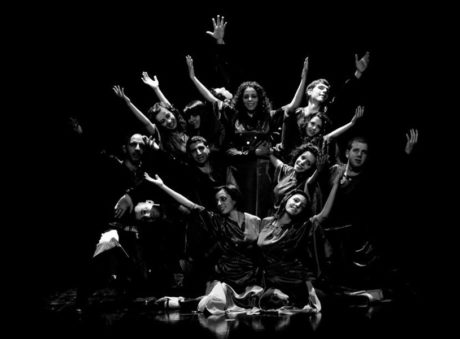
Could you describe the journey of one or two students who came in weighed down by “the stress accumulated from years of living behind concrete walls”? What did you and your colleagues do to help them turn their frustrations into positive creative activities?
One of our students from Jerusalem comes to training three times a week, often arriving late for our rehearsals or to her school classes. Because she’s required to pass the main checkpoint between Bethlehem and Jerusalem, which takes a lot of time and energy, she frequently vents her frustrations.
Through our dance production Out of Place, we helped the dancers involved to talk about traumas they experienced while under curfew when Bethlehem was besieged. Those discussions revealed a lot of suppressed emotions, with students describing their feelings of powerlessness and shame. In those situations, dance becomes not only movement, but an expression of both oppression and hope.
There is an entire generation of Palestinians who were born and raised under occupation. Freedom is only an academic concept to them. Youngsters feel desperate, helpless, and angry. They do not know how to deal with their frustrations. Some even think about life after death, rather than life now. It is important that they work through these emotions and express their thoughts through our programs. We work to replace despair with hope.
Do you think that the U.S. is ready for a Palestinian show like Women, especially in today’s political climate?
We are here in Philadelphia, which is good. I believe people in the U.S are now more aware than they might have been before of the situation in Palestine and the injustices experienced there. I hope that our production will generate discourse and debate among the audience, because I believe we need more of that to happen.
As part of the performance, we offer a Q&A session after each performance to provide the audiences with time to discuss what they have seen and bring up any questions or comments they might have.
Bethlehem plays an enormous role in Christianity. Did the fact that you’re performing in Bethlehem attract not only more visitors from abroad, but did it also give you a certain kind of protection from possible Israeli pressure?
Bethlehem is indeed an inspiration for us as artists in a city that traces its history back over 3,000 years. However, there is no single city or town in Palestine that is protected. In fact, Bethlehem is surrounded by three or four illegal Israeli settlements that do not allow space for growth. It is essentially an open air prison.
Similarly, Christianity in Palestine is not protected either. For example, as a direct result of the occupation, the percentage of Palestinian Christians dropped from 20% of the population in 1920 to 1% in 2017.
However, despite these difficulties, we will host the first Bethlehem International Performing Arts Festival in October 2018. We hope that ten performing arts companies from around the world would come to Bethlehem to perform and share with us our culture, heritage, and our political and social life.
Every year in December, you perform for more than 10,000 people in the West Bank to “educate children and families of the values of family, respect, tolerance and equality through the spirit of Christmas.” How do Muslims respond to your presentation of Christian values?
Christians and Muslims have lived together in Palestine for a long time and respect their mutual influences on each other. For instance, I am a Palestinian Christian who welcomes living in a Muslim culture. The ideals we present, teach, and explore at Diyar Theatre are not only present in one religion, but are universal values that are appreciated by audiences of all backgrounds.
Is there anything else you would like to share with your American audiences?
The Palestinian struggle in today’s reality is critical, not only to Palestinians but also to the whole world, for it is not a struggle of specific people but a human rights issue. At Diyar Theatre, as part of Dar Alkalima University College for Arts and Culture, we are dedicated to advocating peace, hope, and social justice. We do that by reaching out through the beauty of the stage.
We use theatre and dance as a powerful tool to express solidarity, freedom, and equality for Palestinians—for everyone.
Shukran, شكرا, thank you, Rami.
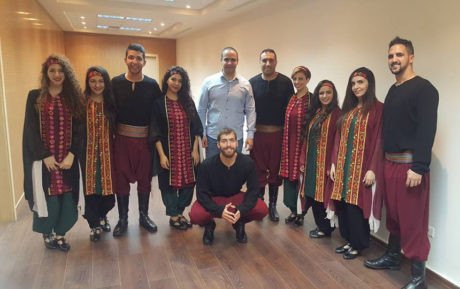
Running Time: One hour, including Q&A session, with no intermission.
Women: From Bethlehem to Philadelphia plays July 15, 2017 at 8 pm at Community Education Center – 3500 Lancaster Avenue, in Philadelphia, PA. For tickets, purchase them online.
The show also plays July 16, 2017 at 6 pm at The Motor House – 120 West North Avenue, in Baltimore, MD. For tickets, purchase them online.


